Eumorpha pandorus
Eumorpha pandorus pandorus
you-MOR-fuhMpan-DOOR-uhs
(Hubner, [1821])
Daphnis
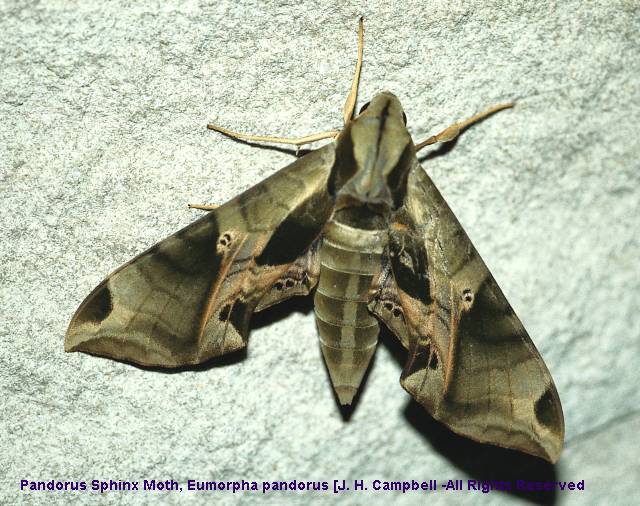
Eumorpha pandorus courtesy of John Campbell.
This site has been created by
Bill Oehlke.
Comments, suggestions and/or additional information are welcomed by
Bill.
| TAXONOMY:
Superfamily: Sphingoidea, Dyar, 1902
Family: Sphingidae, Latreille, 1802
Subfamily: Macroglossinae, Harris, 1839
Tribe: Philampelini, Burmeister
Genus: Eumorpha, Hubner, [1807]
Species: pandorus, (Hubner, [1821]) |
DISTRIBUTION:
The Pandorus Sphinx Moth, Eumorpha
pandorus (wingspan 3 1/4 - 4 1/2 inches (8.2 - 11.5 cm), females
larger than males), flies throughout the eastern half of the
United States from the eastern two-thirds of Oklahoma east to Florida, and north from Minnesota to southwestern Maine.
In Canada they are reported in Ontario, Quebec (rare) and Nova Scotia, but I
have never seen them on Prince Edward Island where I reside. They were common in Pottersville, New Jersey where I grew up as a boy.

Eumorpha pandorus Houston, Texas, April 23, 2005, courtesy of Gil and Larry Nelson.
The moth's upperside is light brown with shades of olive green to green. The forewing
has pink streaks along vein ends and near the inner margin, and a
dark squarish mark at the middle of the inner margin. The area from
the base to the squarish mark is dark green. The underside
usually is yellow-green, but sometimes is pale brown.
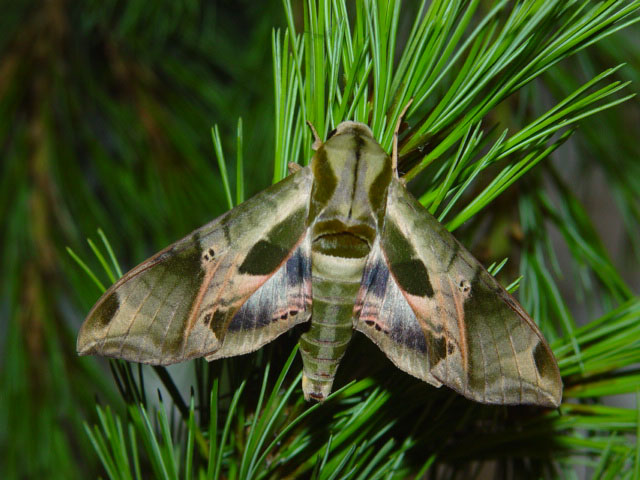
Eumorpha pandorus, Peterborough, Ontario, July 5, 2005, courtesy of Tim Dyson.
FLIGHT TIMES AND PREFERRED FOOD PLANTS:
Eumorpha pandorus adults are on the wing at dusk from June-August as a
single generation in the North and from April - October in the South where there are likely at least two generations. Vernon A. Brou
confirms there are four broods in Louisiana.
During the winter months this species remains in a dormant stage (diapause) as a pupa in a subterranean chamber.
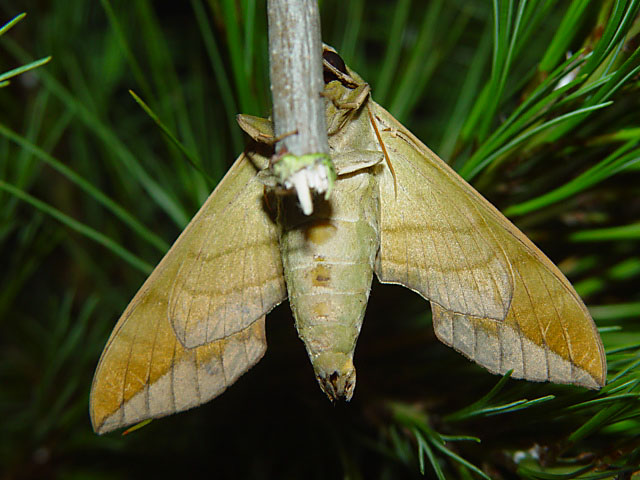
Eumorpha pandorus, Peterborough, Ontario, July 5, 2005, courtesy of Tim Dyson.
Eumorpha pandorus larvae feed upon Grape (Vitis),
ampelopsis (Ampelopsis), and Virginia creeper (Parthenocissus).
Adults feed from flowers including petunia (Petunia hybrida),
bouncing bet (Saponaria officinalis), and white campion (Lychnis alba).
Visit Eumorpha pandorus, Ingleside, southeastern Texas, April 18, 2011, Jack Millen.
Visit Eumorpha pandorus, Hitaga Sand Ridge Prairie Reserve, Linn County, Iowa, June 15, 2012, Thomas Jantscher.
Visit Eumorpha pandorus nectaring at bouncing bet, Flatbrookville, Sussex County, New Jersey.
July 2008, courtesy of Jeff Swick.
Visit Eumorpha pandorus, Rockland, Milam County, Texas, July 20, 2014, Jeremy Sanders.
Eumorpha pandorus, Burlington, Halton Region, Ontario, Canada, July 24, 2012, Nancy Sandeman.
Visit Eumorpha pandorus, Chatham, Kent County, Ontario, Canada, August 3, 2007, John Van der Pryt.
Visit Eumorpha pandorus, Annapolis, Anne Arundel County, Maryland, August 26, 2010, courtesy of Saundra Byrd.
Visit Eumorpha pandorus, Pittsburg, Allegheny County, Pennsylvania, September 4, 2012, Jana Klausman.
Visit Eumorpha pandorus, recto and verso, Lansing, Eaton County, Michigan,
taken at lights, September 9, 1999, courtesy of Harry D. King
Visit Eumorpha pandorus, Pearland, southeastern Texas, September 9, 2011, Kenny and Lisa West, via Linda Benskin.
Visit Eumorpha pandorus life cycle (eggs to adult), courtesy of Greg Bingaman.
ECLOSION, SCENTING AND MATING:
Pupae wiggle to surface just prior to eclosion. Females call at night, and males fly into the
wind to pick up and track the pheromone plume.
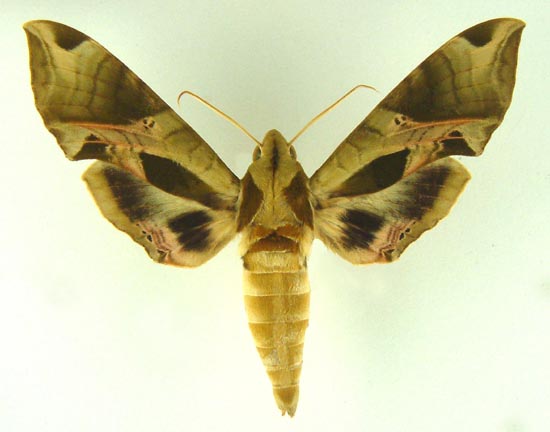
EGGS, LARVAE AND PUPAE:
Females lay translucent green eggs singly on leaves of the host plant. I believe incubation can be as short as four days in summer heat.
Larvae get quite large and consume copious amounts of foliage.
Missing leaves and droppings on the ground, are quick clues that
one of the Eumorpha species is on a vine.
Parasites take a
high toll.
During the winter months this species remains in a dormant stage (diapause) as a pupa in a subterranean chamber.
D J Cohenour reports mature larvae feeding on September 16, 2011, in Greenbrier County, West Virginia, probably from a mid August flight.
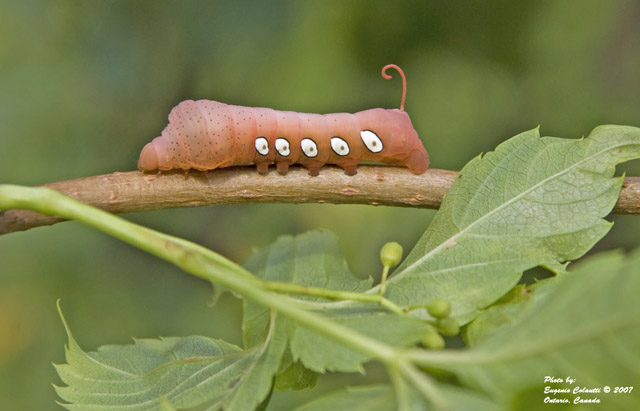
Pandorus Sphinx, Eumorpha pandorus, third instar, August 27, 2007,
Marmora, Ontario, courtesy of Eugenio Colautti.
On August 29, 2007, Eugenio writes, "I hope this is of interest to
you.
"In searching the internet for this I did not find this color or this
curved horn on a Eumorpha pandorus.
"You are welcome to use the photo if you wish.
"Photo taken in Marmora, Ontario."
I wrote back and explained that the horn is not present in the final instar. I am pretty sure the image Eugenio sent is of a third instar larva.
When the Eumorpha pandorus caterpillars first hatch from almost globular dark green eggs
(yellow somewhat just before hatching), the anal horn is dark and as long as the body, ending in two setae. At its base is a red brown
patch extending part way onto the anal shield.
Egg incubation can be as few as six days, and eggs are deposited singly. The hatchling larvae have large pale green
heads and yellow green bodies, feet and legs.
Larvae can shed skins and move into an identical looking second instar, except the heads are now in better proportion to the body
(i.e., don't seem so large) and yellowish-white subdorsal lines and tiny dots are present.
In warm conditions larvae can molt again in as few as three or four days. The five cream coloured, obliquely oval patches, diagnostic
of E. pandorus, appear in the third instar. There is also a visible dark dorsal line and the appearance of small black spots on
thoracic segments, becoming less numerous on the abdominal segments. The horn is still long in this stage, usually red,
and curled forward over the back.
Molting into fourth instar can occur in three to four days. Many larvae now have orange to pinkish-brown to brown skins in the fourth
instar. The anal horn is now greatly reduced, but still present. Just forward of the horn is a small
yellow tubercle with a black circle and centered black dot, marking the spot for the eye, sans horn, of the fith instar.
It is in the fifth instar that most people encouter E. pandorus
larvae. They are voracious eaters, usually for up to another week,
having spent four to five days in fourth instar stage. In the fifth instar thay can be green
to almost black, usually with five obliquely oval patches, sometimes four.
There is no longer any anal horn.
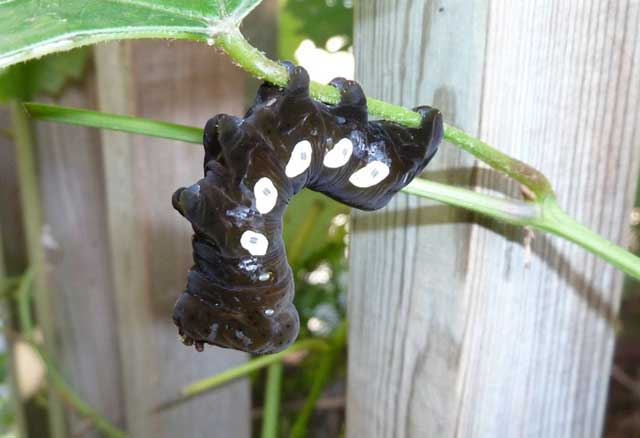
Eumorpha pandorus final instar, black form, Tatamagouche, Nova Scotia,
August 30, 2010, courtesy of Pippa, Chris and Thomas Moss.
I was surprised to see the larva from Tatamagouche, Nova Scotia, as I felt the sporadic reports from that province
were only of adult strays. Pippa confirms that the grape vine upon whichi it was feeding "is well established, being there for over two decades.
The vine it came from was in Nova Scotia even before that. We have no new vines purchased this year but did have a new honeysuckle near it,
from a local nursery.
"The pictures were taken on the 30th Aug. 2010, at about 3:45 p.m. It proceeded to eat the whole vine leaf and was still there when we left for work the
following morning, but had gone when my husband came home that night at about 8 p.m."
The date of the larva find suggest a mid to late July flight time for adult E. pandorus in Nova Scotia.

Sphinx chersis, Canning, Nova Scotia,
August 28, 2017, Krista Melville.
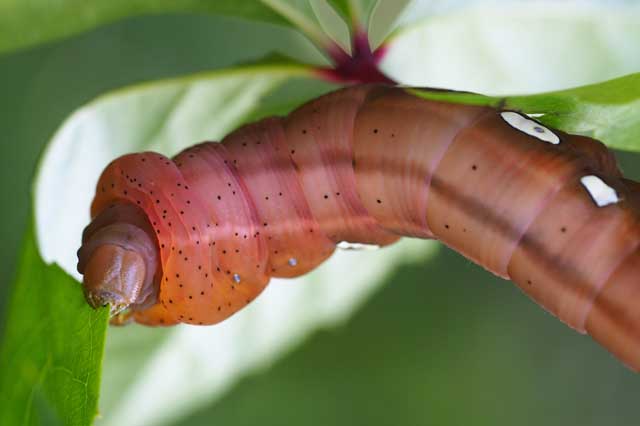
Sphinx chersis, Canning, Nova Scotia,
August 28, 2017, Krista Melville.
Under normal conditions, mature larvae leave foliage and excavate
subterranean chambers in which to pupate. They will pupate, however, in
five to six days in plastic tubs or buckets without soil.
During the winter months this species remains in a dormant stage (diapause) as a pupa in a subterranean chamber.
If you carefully examine grape, Virginia creeper or woodbine foliage
in New England or southern Canada in August-October, you have a good chance of finding E. pandorus larvae.
In mature larvae the abdomen has a small white to yellow spot on the anal segment and a single small dot on each of the first two abdominal segmenst and large oval
spots around each spiracle on segments three through seven. The whiplike horn of early instars is replaced with a button in the
last instar. There is black speckling on the dorsal surface of the thorax and anterior abdominal segments.
When disturbed, the larva quickly retracts the head and first two segments of the thorax into the swollen, third thoracic segment.
There are tan to orangey-brown to almost black as well as green larval forms.
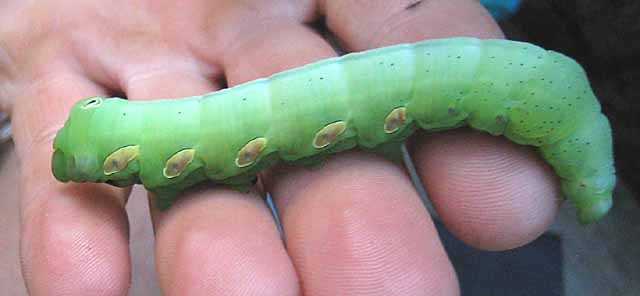
Image courtesy of Scott
Eldridge, Cape Cod, Mass., August 18, 2003
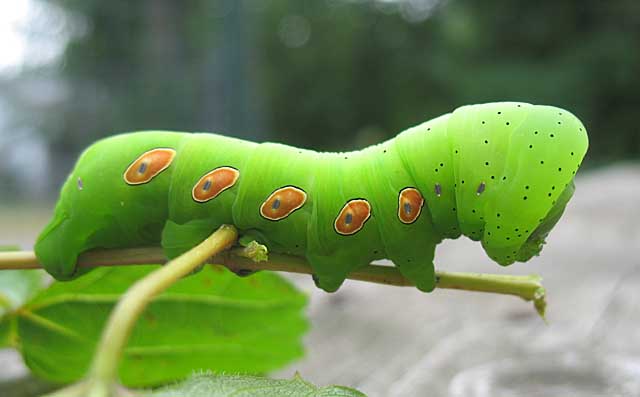
Eumorpha pandorus, Monroe County, Indiana, August 21, 2008, Katie and Monique
Visit Eumorpha pandorus fifth instars on Engelmans's Ivy, August 1, 2011, Kingston, Gayle Beauregard
Visit Eumorpha pandorus green fifth instar, Mississauga, Peel Region, Ontario, August 21, 2014, Caymen Vieira.
Pupation is normally underground, however, larvae will pupate quite successfully without soil, as per article linked from top of page.
The pupa is long and slender with a long cremaster.
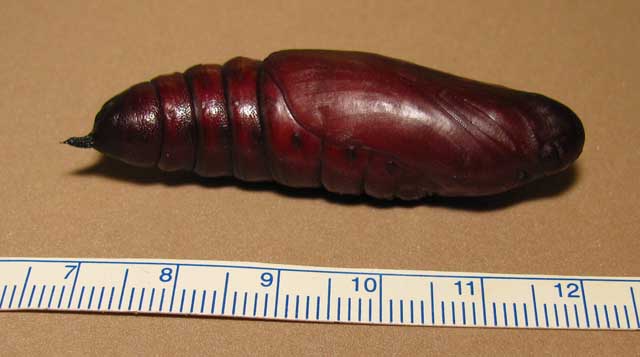
Eumorpha pandorus pupa, ex wild larva, North Warren, Warren County, Pennsylvania,
September 24, 2011, on wild grape, courtesy of Joel Szymczyk.

Eumorpha pandorus pupa, ex wild larva, North Warren, Warren County, Pennsylvania,
September 24, 2011, on wild grape, courtesy of Joel Szymczyk.
Larval Food Plants
Listed below are primary food plant(s) and alternate food plants. It is hoped that this alphabetical listing followed by the common name of the foodplant will
prove useful. The list is not exhaustive. Experimenting with closely related foodplants is worthwhile.
Vitis
Parthenocissus....... |
Grape
Virginia Creeper
|

Image courtesy of David Wagner.
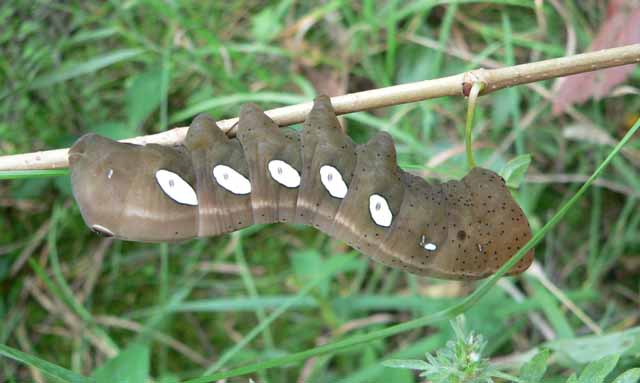
Eumorpha pandorus, Brantford, Ontario, September 10, 2005,
courtesy of Kristine Lee
Return to U. S. A. Table
Return to Philampelini Index
Return to Sphingidae Index
Enjoy some of nature's wonderments, giant silk moth cocoons.
These cocoons are for sale winter and fall. Beautiful Saturniidae moths will emerge the following spring and summer.
Read Actias luna rearing article. Additional online help available.
Use your browser "Back" button to return to the previous page.
This page is brought to you by
Bill Oehlke and the
WLSS. Pages are on space rented from Bizland. If you would like
to become a "Patron of the Sphingidae Site", contact Bill.
Please send sightings/images to Bill. I will do my best to respond to requests for identification help.
 | 
Show appreciation for this site by clicking on flashing butterfly to the left.
The link will take you to a page with links to many insect sites. |
















